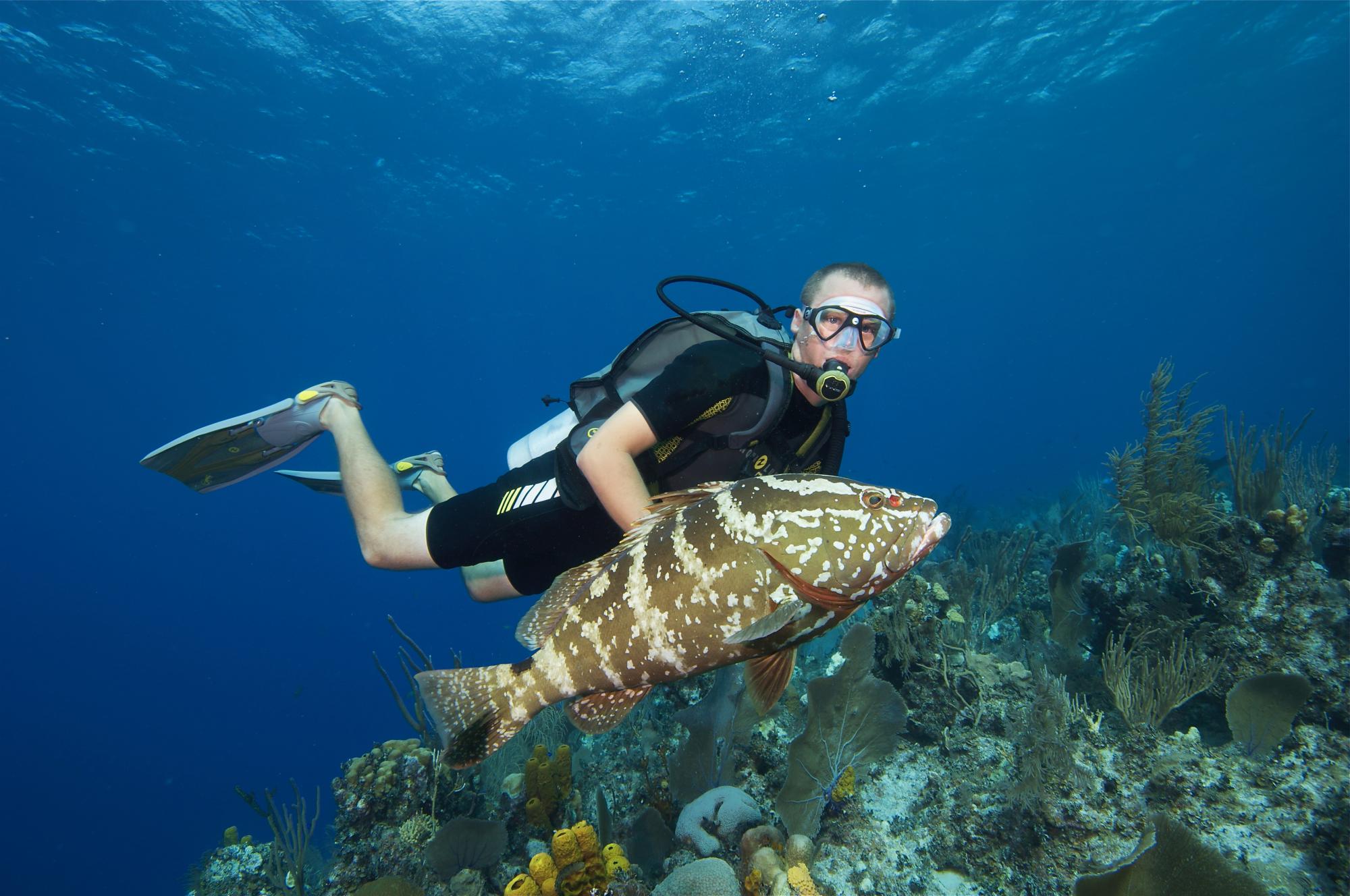The Cayman Connection: Why Liveaboards Are Great for New Divers
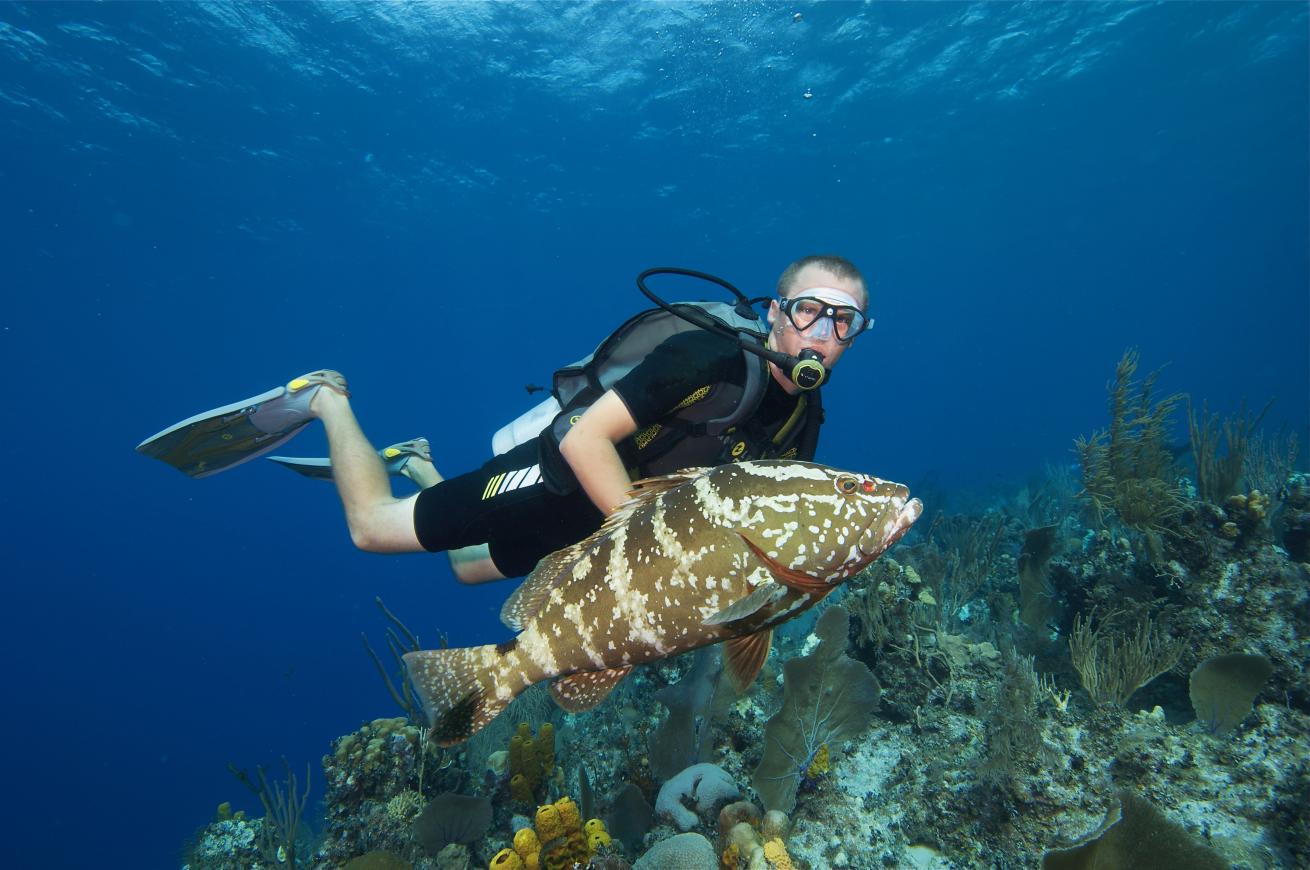
Courtesy Aggressor LiveaboardsThe Cayman Islands are known for limitless visibility and critters like this friendly Nassau grouper.
Sometimes, the gods smile. And sometimes, they laugh out loud.
Preparing for our checkout dive, we hear an encouraging word: Hammerheads have been seen here, and recently.
Yeah, that’s not gonna happen, I think as I stride off the deck of Cayman Aggressor IV and sink toward John Halles Wall, a beautiful site at the edge of Grand Cayman's immense North Sound.
Almost immediately, instructor Ruben Arias is frantically making Princess Leia buns with his fists: the sign of the hammer. Below, we clearly see that sexy, sinuous shape that can’t be anything else.
It gets better. Not only do we see a hammer—two, in fact—but half the group encounters something truly rare: a manta. In Cayman! On our very first dive!
Whether you’re a veteran diver or brand-new, Cayman will surprise you.
The Wisdom of the Tribe
The dive life offers many gifts, some unique to liveaboards, dive-centric yachts that typically only return to port every week or more. Among 18 passengers and 7 crew—ranging from a well-known pro shooter to an Alabama club that’s been diving together for 40 years—there are more than 500 years of lived dive experience on this yacht. No amount of instruction or day-boat dives can give new divers that kind of proximity to comrades ready to help, not to mention up to 27 dives in just a week.
Another of those gifts, for North Americans, is easy access to the Cayman Islands, a storied destination. Cayman is known for its walls, but for new divers, that doesn’t convey what you’ll see. “Stacks” might be more descriptive—picture all the little houses of Hobbiton layered 30 stories deep in a Tolkienesque Middle Earth under the sea, an ever-changing kaleidoscope of busy, colorful communities surging all around you.
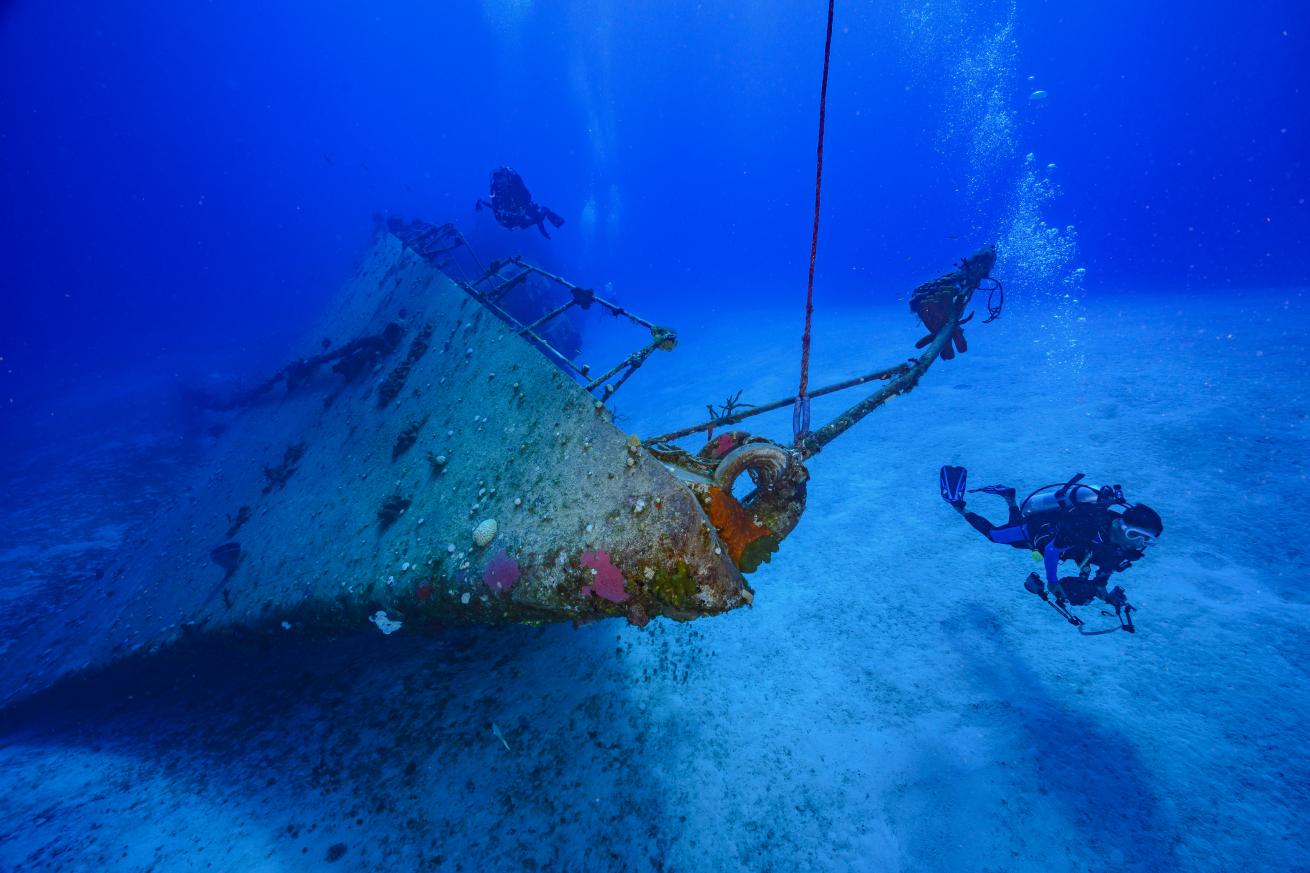
Courtesy Aggressor LiveaboardsWreck diving abounds off both Grand Cayman—home to the former USS Kittiwake—and Cayman Brac's M/V Captain Keith Tibbetts.
Baby Steps
Let’s be honest: Not every newbie longs to encounter an apex predator on their very first ocean dive. (Or, possibly, ever. And that’s OK!)
Before he was certified, “I was a little afraid of all the stories,” Arias recalls. Divers often ask pros for their hairiest moments. Arias avoids those tales. “I don’t like putting those fears on others the way they were put on me.”
New divers also can be put off by the cost of a liveaboard, which often starts at around $3,000 per person per week. But do the math: What would you expect to pay for a week in a hotel; three meals a day, plus snacks, beer and wine; perhaps four dives a day with an underwater guide; and a rental car to get around to all of it? On Grand Cayman, that cost could skyrocket to double or more.
More importantly, aside from the chance to get past the Shark Week hype and experience the undersea world for yourself, liveaboards offer new divers a place to work on everything from buoyancy to weights, navigation, fish ID and managing your equipment—then to do it again and again and again until you feel confident with a wide range of skills.
(Also, minds may be blown.)
A Long Way Up
At first-night introductions, there’s something familiar about our second captain and cruise director, Javier. Back in my cabin I start googling and realize, holy cow, he’s Luis Javier Sandoval, a well-known underwater photographer and a repeat winner in Scuba Diving’s annual photo contest. He tells me later the Aqualung Legend LX regulator he’s using was a Scuba Diving prize and shares why having and understanding good equipment is so important.
When he started as a diver more than two decades ago, money was tight. On a trip to the Revillagigedo Archipelago, diving “a Frankenstein reg,” he descended before the group to set up his shot. In heavy current, he turned his head and the second stage blew apart. Forty meters deep, he looked to the surface and thought “Damn, that’s a long way” as a tiny finger of fear began to tickle. But he got hold of himself and his octo, and from that moment made good equipment a priority. “Same with fins and mask,” he tells me as we’re hanging out on CAIV’s dive deck, where there's more than enough room for all of our gear. “It’s important to care about getting equipment you are confident in and getting used to it.”
A less essential—and inexpensive—piece of equipment can also make a big difference: a dive light.
Babylon, off Grand Cayman’s northeast coast, is one of the island’s most-requested sites for good reason. As soon as we descend on an early morning dive, the dusky landscape is dramatic. We slip down a narrow passage between pinnacle and wall, and begin circling up through lacy black coral that forms a dreamlike veil. There’s something to see covering every inch, from sponge life in all shapes and colors to clouds of creole wrasse, damsels and juvenile parrotfish; we could have gone round and round forever.
When we splash in again a couple of hours later, I’m sad to see Sandoval take off in the opposite direction—but thrilled to find it equally breathtaking. Cruising high along the wall just before the sun peeks over, each little promontory is a delight, covered in hearty stands of gorgonians harboring dozens of species of reef fish. I find myself wondering how I could have missed that black durgons are neither black nor blue—my dive light reveals delicate, multi-colored facial markings that can run brown, green, yellow and purple. Clouds of creole wrasse and small schools of yellowtail snapper are everywhere, and a big mutton snapper paces us like a hound dog.
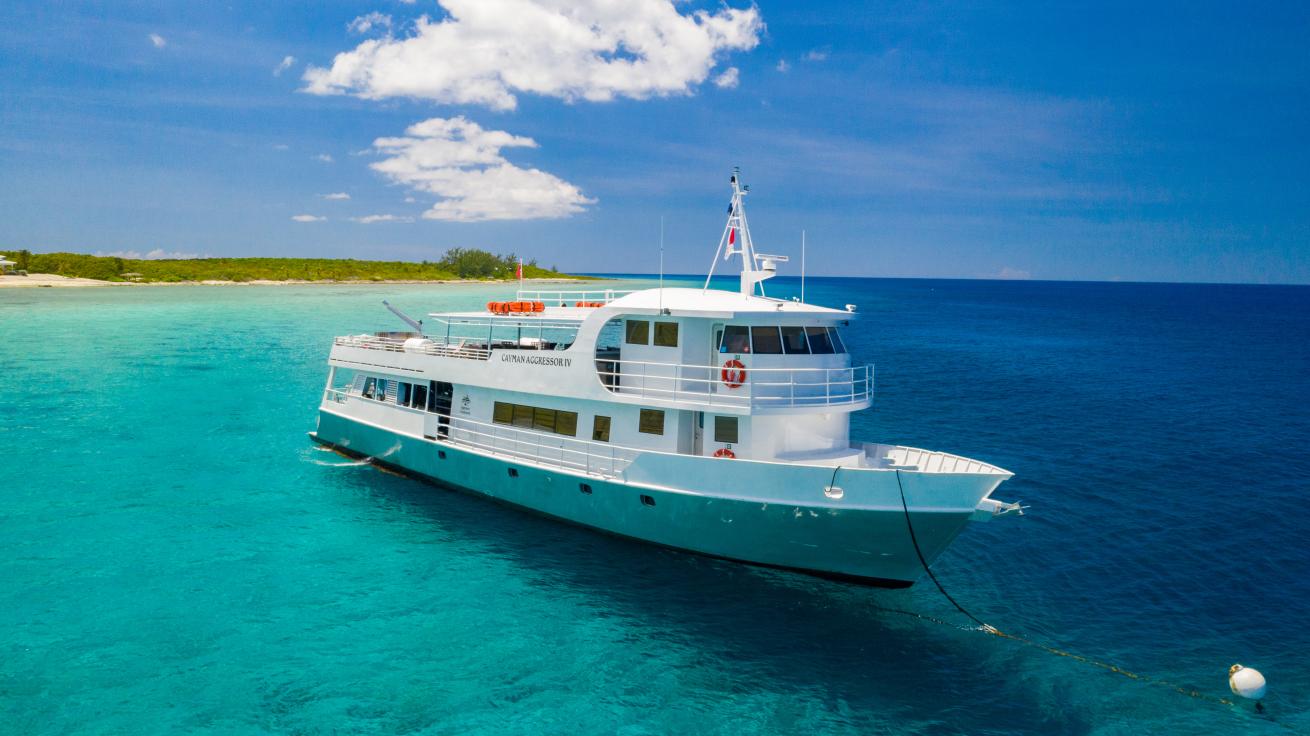
Courtesy Aggressor LiveaboardsCayman Aggressor IV features an air-conditioned salon and a sun deck complete with a hot tub, wet bar and kickin' sound system.
Eye to Eye
Good buoyancy is not just a skill you learn in class—it’s key for improving air consumption, carrying less weight and, most importantly, increasing spatial awareness so you keep yourself and the fragile kingdom around you safe. It’s the most basic thing, yet everyone struggles, even experienced divers if they’ve been dry for a while.
Related Reading: How To Achieve Perfect Buoyancy On Every Dive
“I was trained by cave divers,” says Arias, “and they concentrate on position, but first it was buoyancy, buoyancy, buoyancy. Before anything else, make sure that’s good.”
“The only way to get better,” Sandoval adds, “is to feel how depth causes changes in the lungs. It comes with experience.”
Your buoyancy, and how much weight you need, also will change with different scenarios and exposure suits. “The best thing is to try different environments,” Sandoval says, “and write it down.” Recording your weights, conditions and garments in a dive log makes it a lot easier to dial in your buoyancy the next time.
Good buoyancy comes in handy in an unexpected close encounter on Kittiwake, one of the best-known wrecks in the Caribbean. In 2017, Tropical Storm Nate tipped the 251-foot former sub tender to port, making a great dive new all over again. It’s a little spooky, in a carnival funhouse way, but well-prepared for divers of all levels. It’s so good, we do it three times on day one.
Hanging outside the bridge shooting a trio of portholes festooned with life, I suddenly realize there’s a huge animal staring back at me—a resident goliath grouper. Eventually, it gets interested in my video lights and comes just inches from the bulkhead, smacking its enormous lips and giving me a great view of its gullet—amazing to be eye to eye with such a creature for as long as I cared to hover.
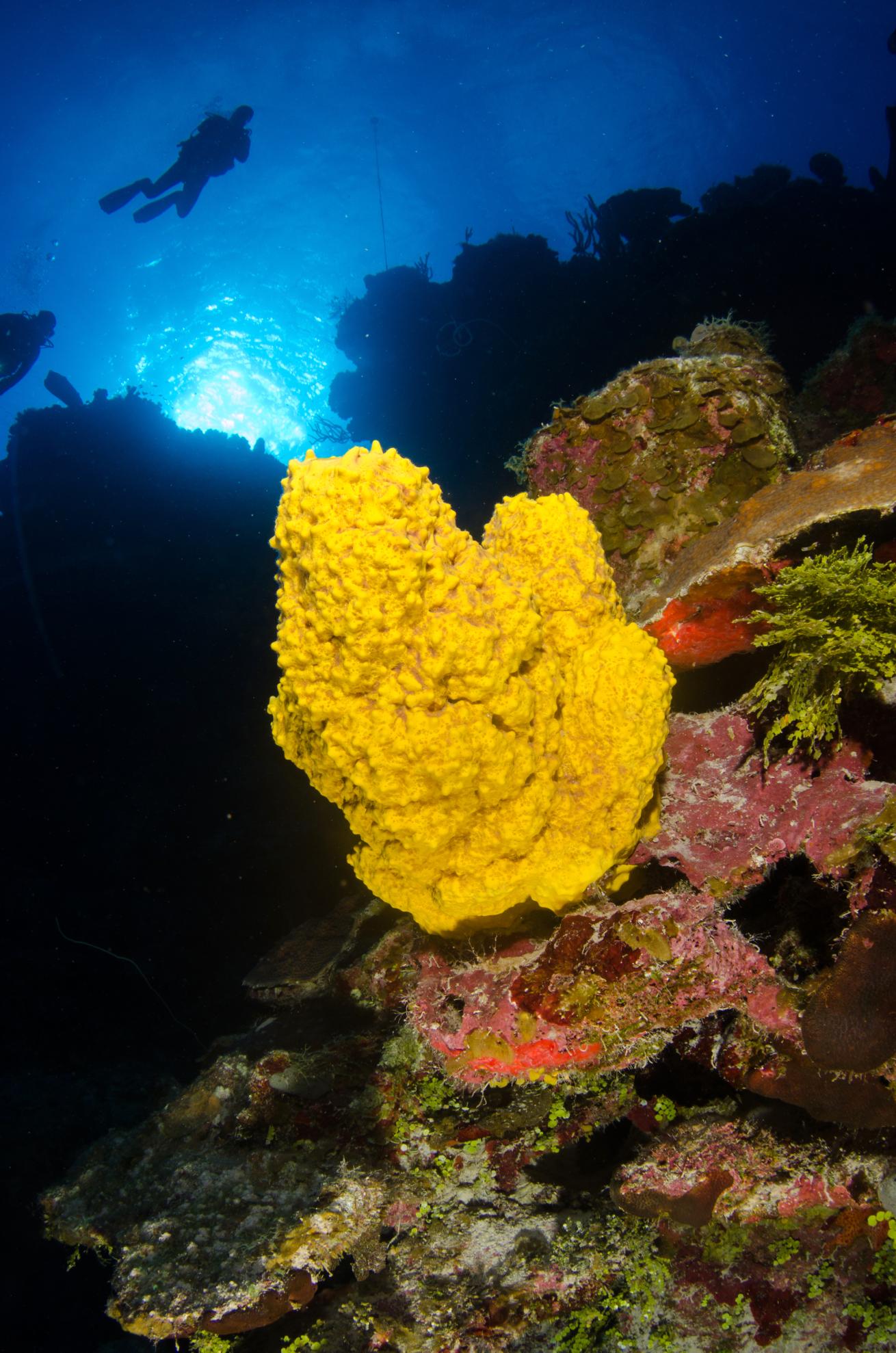
Courtesy Aggressor LiveaboardsGrand Cayman's colorful walls and clear water make it a good choice for photographers.
Nighttime: The Right Time
Many divers are reluctant to take the plunge at night. (It’s dark! We get it.) But night dives are all about the little stuff, and that means they often take place in a small area, usually very close to the yacht. It’s a great time to practice both navigation—you’re never far from the boat, nor very deep—and fish ID, because you can actually see better and more accurately in your lights. Plus, different stuff comes out to play after the sun goes down.
At the Oro Verde, a wreck-of-a-wreck scattered across the sand at the southern end of Cayman’s Seven Mile Beach, the fun starts as we giant-stride into a school of juvenile bar jacks that fills the water column from surface to sand, a living curtain stretching 50 feet in all directions. The white crystalline bottom reflects back the waning moon, and we can clearly see the jacks even without lights—magical, and we’ve barely left the ladder.
Descending, we spy half a dozen tiny squid, followed by two adults in iridescent hues, their little fins fluttering like rotors. Moving on to the bow of the wreck, I’m struck by how much clearer its colors are at night, running the whole spectrum of the rainbow. I quickly find my target: a blue-green Caribbean reef octopus that glides, sways, billows and contracts in constant, fluid motion. Mesmerizing.
From there, it’s just a parade, including an enormous rainbow parrotfish wedged in the wreckage, its face more than a foot from chin to forehead, and a free-ranging conch, googly eyes way out. We spend some time looking at engine parts—more impressive at night—that shelter dozens of eerie, filamentous knobby anemone that curl up like the East Witch under Dorothy’s farmhouse in our lights. Creepy, but fun. I motor about the rest of the dive in childlike bliss and consider refusing to leave when my buddy signals time.
Diving Is Not Swimming
“l wish I could have been persuaded that diving is not competitive,” Dr. John Nelson tells me with a sigh, reflecting on his advice for new divers. We’re relaxing on CAIV’s spacious, comfortable upper deck, the social heart of the yacht, where early risers greet the sun with a cup o’ joe and night owls stargaze with a Caybrew in hand.
A veteran diver of more than 40 years, the El Paso Community College history professor ruefully describes prioritizing “farther, deeper, faster,” sometimes swimming past three different dive-site buoys while “somebody who stayed under the boat saw more than I did.”
Arias, the dive instructor, has another take on swimming. I notice he typically glides through the water in a perfect Superman posture, arms straight, hardly twitching a muscle. Why? The less movement, the more efficient your air consumption. “I can see my computer with no motion,” he says of his wrist-mounted device. “The less you move, the better. Your fins are for propulsion, not your hands.” A liveaboard is the best place to practice this and more, he says. “It gives you time to get to know yourself as a diver. Even if you only do two dives a day, by the end of the week you’ll improve so much.”
“Ask a lot of questions,” says Judi Willis, a 38-year diver from Orlando, “and get your advanced and rescue.” She and her husband, David, both accomplished photographers, are fun to watch underwater, reminding me of a pair of butterflyfish—purposeful, perfectly matched, never far apart. “Best class I ever took,” David says of his rescue cert. “It teaches you early warning signs of problems for a diver.”
On a liveaboard, such tips can come from anywhere. Chef Carlos Sabate, the man who’s been keeping us stuffed and happy every minute we’re not underwater, turns out to be an instructor. He notices I’m sitting out a dive and cocks an eyebrow. I tap my ears, which sometimes balk at five dives a day. (And that’s OK! Five dives are generally available, not required.)
He crooks a finger, and I follow him to the galley, where he hands me a small bottle of Jaloma coconut oil. He instructs me to put a tiny bit on my pinkie and massage the inside of my ear after I’ve dosed with the 50/50 alcohol-vinegar concoction I swear by to discourage bacteria and fungi. The oil is delightfully soothing and smells great to boot. I’m sold, and my ears are happy.
Related Reading: The Best Destinations for Wreck Diving
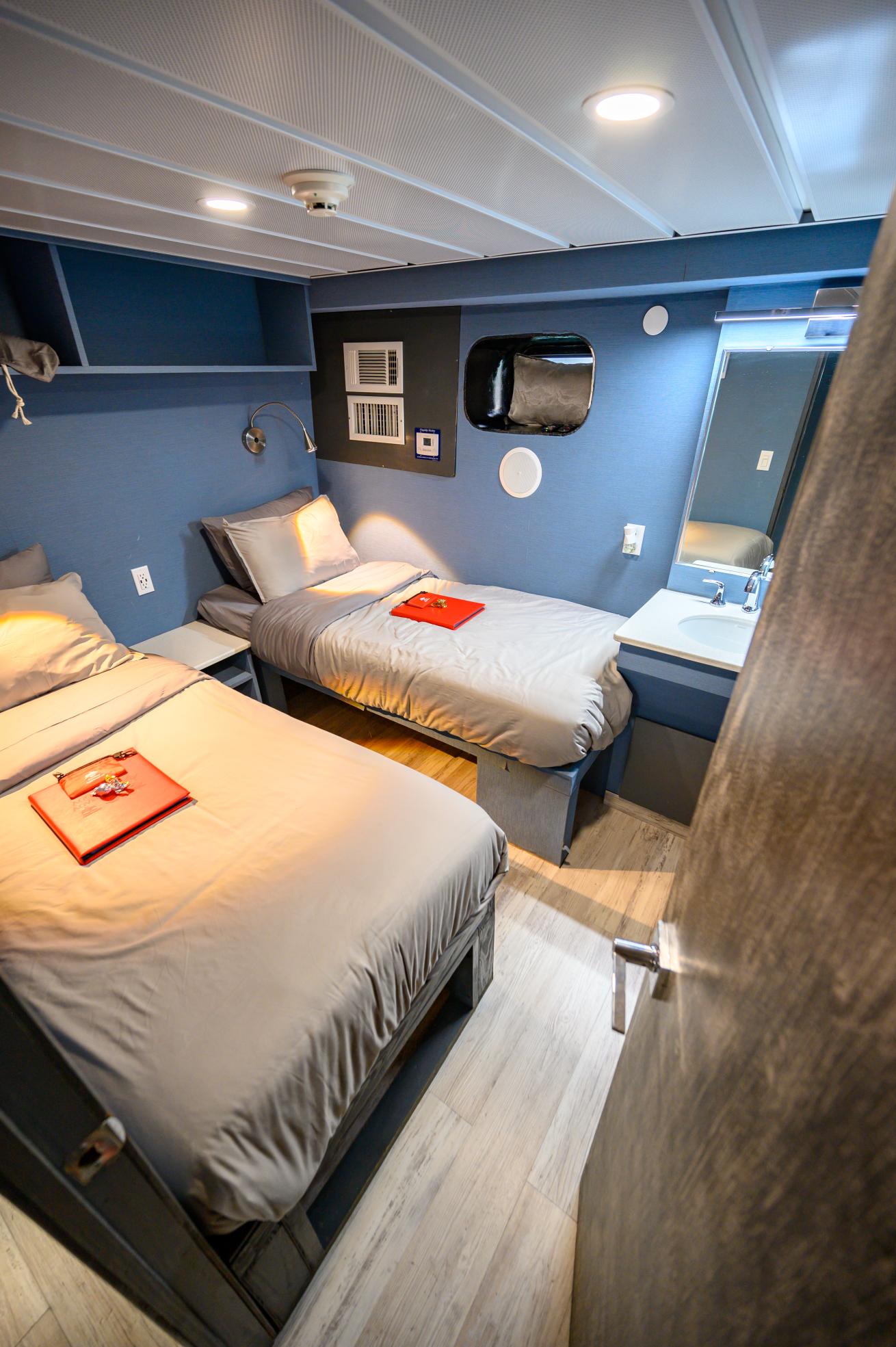
Courtesy Aggressor LiveaboardsCAIV's nine staterooms, which accommodate 18 divers, include king, twin and bunk-style accommodations, all with private bathrooms.
Basking in the Light
There’s just one more site, one that often closes the week on CAIV: Devil’s Grotto, a legendary dive that’s only about 200 yards from George Town Harbour. It’s also proof that the best sites can be shallow—much of the grotto is just 15 feet deep. (It’s another good place to practice your navigation. If you get turned around, pop your head up and take a sighting on the yacht.)
Formed by erosion over eons of rising and falling seas, along with hungry carbonate-loving organisms, the small caverns go on and on, pierced with shafts of sunlight. The formations are impressive, but it’s the shimmering, ethereal light that makes this dive unforgettable.
There’s much life along the sand, too, from spotted drum to a big stingray to a grouper cleaning station. Rounding the end of a long finger of coral, I suddenly hear one of the Alabama divers holler WAHOO! through his reg. A small eagle ray is winging toward us, pausing here and there to snuffle about in the sand. We keep pace with it for a long while, until it turns into the blue, and we, too, must return to our own world.
Back at the dock at last, there’s one question left: Now that you have the keys to the kingdom, where will you go next?
NEW DIVERS: LEARN FROM THIS
Tips from veteran divers and staff aboard a Cayman Aggressor IV sailing in June 2023
Buddies
Finding the dive shop or club that’s right for you is like finding your dream realtor: Keep looking for the one that gets you. They’re out there. —Mary Frances Emmons
Having a good buddy—the right buddy—will help keep you active in the sport. —David Willis
Computers
Understand what your computer is telling you. Being locked out of your computer for 24 hours because you missed a safety stop is especially not fun on a liveaboard, where you can’t just pick up and go someplace else for the day. Make sure you know where the No Decompression Limit is and to conduct all your safety stops. —MFE
Discomfort
If you’re anxious about a dive, don’t do it. Don’t let anybody talk you into a dive. —Judi Willis
If you’re cold, get out of your wetsuit and get dry, then put it back on. If you get dry first, you will feel better. —JW
Ears
Equalize all the way down. —William Sisk
Let your ears be a gauge: Are they under pressure? You’re going down. Popping? You’re going up. —Luis Javier Sandoval
Navigation
Momentarily misplaced your buddy? It’s easier to see bubbles if you look higher in the water column. —LJS
The yacht swings—use the mooring pin, not the boat, as your point of reference. —LJS
Night Dives
Plan your dive in the shape of a flower, with the yacht at the center of the “petals,” and you’ll always be within sight of the boat. Can’t see it? Cover your light and look up—you’ll see the vessel lights. —LJS
Pesky things like blood worms, sea wasps and other jellies can come out at night; a quick blast from your secondary regulator will give you time to move away or get up the ladder. —MFE
Safety
The ocean does not stop moving, which means the yacht can jog in unexpected directions. One hand for you, one hand for the boat, always. —MFE
Most dangerous thing in diving? The ladder. If you are in the water, don’t take your eyes off it, and don’t approach until the crew tells you to do so. —MFE
Ladder bouncing while you’re trying to remove your fins? Stand on it. Your weight will settle it. —LJS
Sea Sickness
Chew up a Starlight Mint just before you hit the water—it will help with both seasickness and dry mouth. —Donna Love
Give yourself time. You will acclimate to the motion of the ocean in a day or two. —Ruben Arias
Cayman Aggressor IV: Need to Know
When To Go
The Cayman Islands is a year-round dive destination. The rainy season runs from June through October.
Dive Conditions
Water temperatures typically run from the low 80s in summer to the high 70s in winter. Average visibility is around 100 feet, but at many sites can seem almost endless.
What To Bring
Repetitive diving even in warm water is often more comfortable with some protection, although many divers opt for a swimsuit and rash guard. A 1–3mm wetsuit or shorty is recommended in summer, with up to 5mm in January and February. Dive computers are mandatory. CAIV does not allow spear fishing or collecting; gloves are not permitted in the Cayman Islands, to discourage touching of any kind.
Suggested Training
If you don’t already have them, you can get your Advanced Open Water and Enriched Air/Nitrox certifications onboard the yacht.
Getting There
Cayman Aggressor IV’s home port is George Town, Grand Cayman. Numerous carriers offer direct flights from the United States to Owen Roberts International Airport (GCM), about a 10-minute cab ride from the port.
Operator
Aggressor Adventures (aggressor.com) operates the 110-foot steel-hulled Cayman Aggressor IV, which dives Grand Cayman, Cayman Brac and Little Cayman, weather permitting. The yacht, which has a 25-foot beam, accommodates up to 18 passengers in 10 staterooms, each equipped with individual A/C and private bathrooms.
Price
Prices start at $3,295 per person, double occupancy, nitrox not included, for seven-night cruises with five-and-a-half days of diving. Port fees of $95 per person (for seven-night cruises) are not included.

